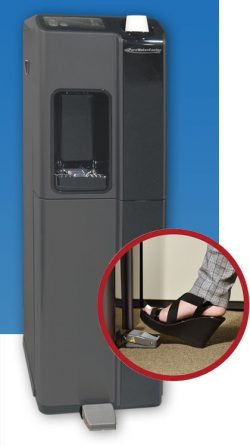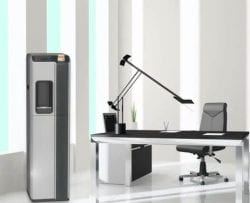Reverse Osmosis vs. Carbon Filtration
One of the most common questions we receive is about the filtration options for bottleless water coolers. While we offer a range of water filtration options, the two leading technologies are Reverse Osmosis Filtration and Activated Carbon Filtration.
While either option will improve the purity and taste of your water, they are markedly different in terms of process and purpose.
Activated Carbon Filtration
Sometimes called “carbon block” filters, Granular Activated Carbon Filters work by running water through a specially manufactured carbon medium. Activated Carbon has been processed to have an incredibly large surface are – a single teaspoon of Granular Activated Carbon has the area of a football field, and a single pound is equivalent to 125 acres.
As water moves through the carbon filter, impurities bond with the carbon, which reduces tastes and odors often found in tap water. This process is called adsorption. Activated Carbon filters are used in drinking water treatments to adsorb natural organic compounds, taste and odor compounds, and synthetic organic chemicals.
Activated Carbon filters can be effective in reducing hundreds of impurities, including contaminants and other chemicals from tap water. Studies cited by the Environmental Protection Agency (EPA) and NSF claim that Activated Carbon can be effective in the removal of 60-80 chemicals, reduction of 30 chemicals, and moderate reduction of 22 chemicals. Activated Carbon is the only filtering material that removes all 12 identified herbicides and 14 pesticides, along with all 32 identified organic contaminants.
Reverse Osmosis Filtration
In a Reverse Osmosis, or “RO,” water filter, your regular water pressure pushes the water through a semipermeable membrane and additional filters to remove impurities, which are then flushed down the drain. This drinking water filtration system is called “reverse” osmosis because the pressure forces the water to flow in the reverse direction as natural osmosis—from the high-concentrated solution to the diluted solution.
According to the EPA, Reverse Osmosis water dispensers use approximately three times as much water as they treat but are effective in eliminating all disease-causing organisms and most chemical contaminants. Reverse Osmosis water filters remove a wide range of contaminants and minerals from your drinking water, including sand, chlorine, fluoride, cryptosporidium, and hexavalent chromium.
Reverse Osmosis filtration can remove 90% of total dissolved solids (TDS) and reduce 97% of all contaminants in your tap water.
Key Differences
The key difference between Reverse Osmosis filters and Granular Activated Carbon filters is the presence of a high-quality, semipermeable membrane.
Carbon filtration is most effective at removing or reducing impurities such as sediment, volatile organic compounds (VOCs), pesticides, herbicides, chlorine, and its by-products. It is also an unchallenged taste-and-odor improver.
Reverse Osmosis filtration is effective for the treatment of bacteria, viruses, total dissolved solids (TDS), and heavy metals. TDS includes sodium, calcium, magnesium, and inorganic minerals. Heavy metals include iron, lead, cadmium, and aluminum.
Which Water Filtration System Is Best?
While Reverse Osmosis is a powerful technology, it is not necessarily the best water filter for your home or office water cooler. RO is best suited to address the two issues for which it was originally designed: desalinating brackish water or seawater and reducing very specific chemical contaminants.
You might need Reverse Osmosis filters if your drinking water supply has high levels of fluoride, sodium, total dissolved solids (TDS), or chemicals like arsenic, radium, nitrates, and nitrites.
If you are not facing challenges with specific contaminants, Activated Carbon Filters are likely the best choice for your home or business. The filtration process is about three times faster, it uses significantly less water, and the taste improvement is second-to-none.




